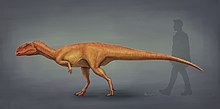Berberosaurus
| Berberosaurus Temporal range: Early Toarcian,
| |
|---|---|

| |
| Life restoration and size comparison | |
| Scientific classification | |
| Kingdom: | Animalia |
| Phylum: | Chordata |
| Clade: | Dinosauria |
| Clade: | Saurischia |
| Clade: | Theropoda |
| Clade: | Averostra |
| Clade: | †Ceratosauria |
| Genus: | †Berberosaurus |
| Species: | †B. liassicus
|
| Binomial name | |
| †Berberosaurus liassicus Allain et al., 2007
| |
| Synonyms | |
| |
Berberosaurus (meaning "Berber lizard", in reference to the Berbers of Morocco) is a genus of neotheropod dinosaur, possibly a ceratosaur, from the Early Toarcian-age (Lower Jurassic) Azilal Formation found in the High Atlas of Toundoute, Ouarzazate, Morocco. The type species of the genus Berberosaurus is B. liassicus, in reference to the Lias epoch. Berberosaurus might be the oldest known ceratosaur, and is based on partial postcranial remains.
Classification[]
Ronan Allain and colleagues, who described Berberosaurus, performed a phylogenetic analysis and found their new genus to be the most basal known abelisauroid, more derived than Elaphrosaurus, Ceratosaurus, and Spinostropheus, but less so than Xenotarsosaurus and abelisaurians. Berberosaurus is distinguished from other theropods by anatomical details found in its vertebrae, metacarpals, and hindlimb bones. Its assignment as an abelisauroid pushes back the record of this group and shows that it had diversified by the Early Jurassic.[2] However, Carrano and Sampson (2008) found it to be a basal ceratosaur outside Neoceratosauria instead.[3] Subsequently, the analysis of Xu et al. (2009) recovered it as a dilophosaurid in unresolved polytomy with Dilophosaurus wetherilli, "Dilophosaurus" sinensis, Dracovenator and Cryolophosaurus.[4] The phylogenetic analysis performed by Ezcurra, Agnolin and Novas (2010) recovered Berberosaurus in unresolved polytomy with Ceratosaurus and Abelisauroidea,[5] while the 2018 description of the basal ceratosaur Saltriovenator places Berberosaurus as the sister taxon to that genus.[6] Same year, a paper found Berberosaurus in different positions: considered as a basal ceratosaurian, a neoceratosaurian, a basal abelisauroid or sister-taxa of .[7]
Discovery and history[]
The remains of Berberosaurus were discovered during a series of expeditions to the High Atlas beginning in the early 2000s. It is based on an associated partial postcranial skeleton of a subadult individual cataloged in the ; bones from this skeleton include a neck vertebra, part of the sacrum, a metacarpal, a femur, and parts of a tibia and both fibulae. Part of another femur has been assigned to the genus as well. Its remains were found alongside those of Tazoudasaurus and an indeterminate theropod within bone beds in mudflow deposits. Later tectonic activity has affected the bones.[2]
Paleoecology and paleobiology[]
Berberosaurus, like other ceratosaurians, was a bipedal carnivore.[8] It was of moderate size; its estimated femur length of 50.5 centimetres (19.9 inches)[2] is comparable to femur lengths given by Gregory S. Paul for animals like Elaphrosaurus (52.9 cm (20.8 in))[9] and Dilophosaurus (55.0 cm (21.7 in)).[10] Its remains were found with those of the early sauropod Tazoudasaurus. Also from the Early Jurassic of the High Atlas, but from another formation, are the fossils of another, smaller theropod (currently in preparation).[2] It's been estimated to be 5.1 meters (16.7 ft) long and 220 kg (485 lbs) in weight.[11]
See also[]
- Timeline of ceratosaur research
References[]
- ^ Torices, A. (2013). "Theropod dinosaurs from the Upper Cretaceous of the South Pyrenees Basin of Spain". Acta Palaeontologica Polonica. doi:10.4202/app.2012.0121.
- ^ a b c d Allain, Ronan; Tykoski, Ronald; Aquesbi, Najat; Jalil, Nour-Eddine; Monbaron, Michel; Russell, Dale; Taquet, Philippe (2007). "A basal abelisauroid from the late Early Jurassic of the High Atlas Mountains, Morocco, and the radiation of ceratosaurs" (PDF). Journal of Vertebrate Paleontology. 27 (3): 610–624. doi:10.1671/0272-4634(2007)27[610:AADTFT]2.0.CO;2.
- ^ Carrano & Sampson, 2008. The phylogeny of Ceratosauria (Dinosauria: Theropoda). Journal of Systematic Palaeontology. 6, 183-236.
- ^ Xu, X.; Clark, J.M.; Mo, J.; Choiniere, J.; Forster, C.A.; Erickson, G.M.; Hone, D.W.E.; Sullivan, C.; Eberth, D.A.; Nesbitt, S.; Zhao, Q.; Hernandez, R.; Jia, C.-K.; Han, F.-L. & Guo, Y. (2009). "A Jurassic ceratosaur from China helps clarify avian digital homologies (supplementary information)" (PDF). Nature. 459 (7249): 940–944. doi:10.1038/nature08124. PMID 19536256. S2CID 4358448.
- ^ Ezcurra, M.D.; Agnolin, F.L.; Novas, F.E. (2010). "An abelisauroid dinosaur with a non-atrophied manus from the Late Cretaceous Pari Aike Formation of southern Patagonia" (PDF). Zootaxa. 2450: 1–25. doi:10.11646/zootaxa.2450.1.1.
- ^ Dal Sasso, Cristiano; Maganuco, Simone; Cau, Andrea (2018). "The oldest ceratosaurian (Dinosauria: Theropoda), from the Lower Jurassic of Italy, sheds light on the evolution of the three-fingered hand of birds". PeerJ. 6: e5976. doi:10.7717/peerj.5976. PMC 6304160. PMID 30588396. S2CID 56894865.
- ^ Delcourt, R. (2018). "Ceratosaur palaeobiology: new insights on evolution and ecology of the southern rulers". Scientific reports. 8 (1): 1–12. Retrieved 6 March 2022.
- ^ Tykoski, Ronald B.; Rowe, Timothy (2004). "Ceratosauria". In Weishampel, David B.; Dodson, Peter; Osmólska, Halszka (eds.). The Dinosauria (Second ed.). Berkeley: University of California Press. pp. 47–70. ISBN 0-520-24209-2.
- ^ Paul, Gregory S. (1988). Predatory Dinosaurs of the World. New York: Simon & Schuster. pp. 266. ISBN 0-671-61946-2.
- ^ Paul, Gregory S. (1988). Predatory Dinosaurs of the World. 268.
- ^ Molina-Pérez & Larramendi (2016). Récords y curiosidades de los dinosaurios Terópodos y otros dinosauromorfos. Barcelona, Spain: Larousse. p. 255.
- Abelisaurs
- Early Jurassic dinosaurs of Africa
- Jurassic Morocco
- Fossils of Morocco
- Fossil taxa described in 2007
- Taxa named by Dale Russell
- Taxa named by Philippe Taquet













